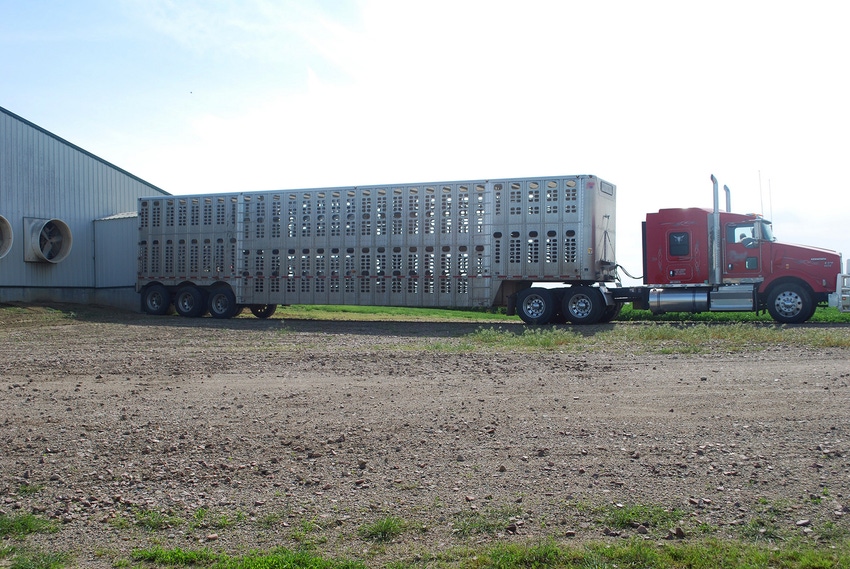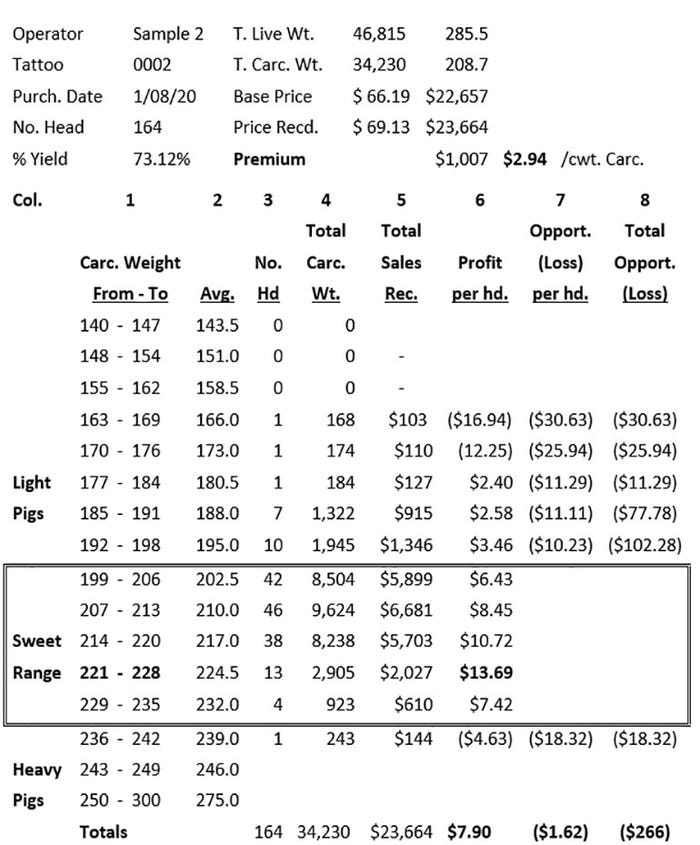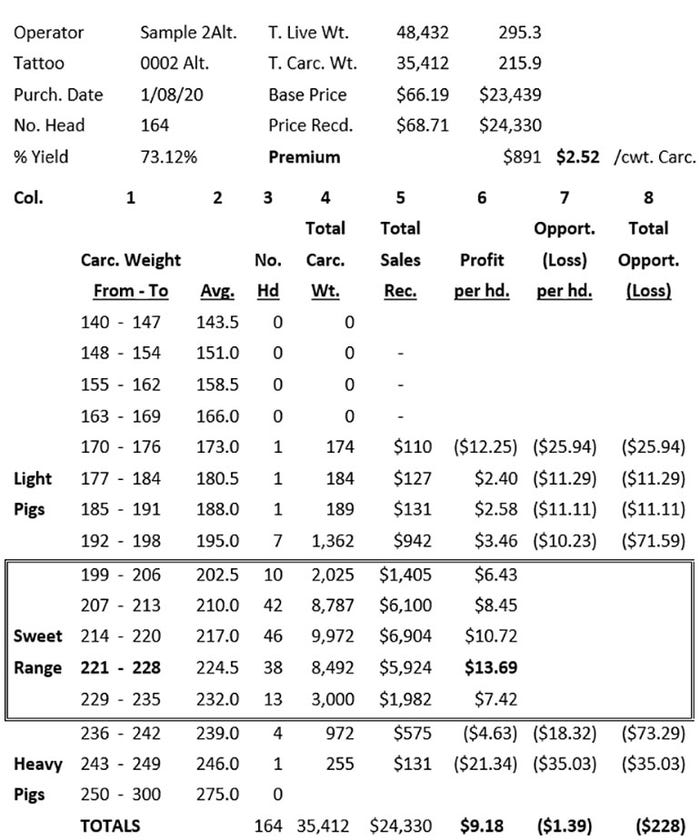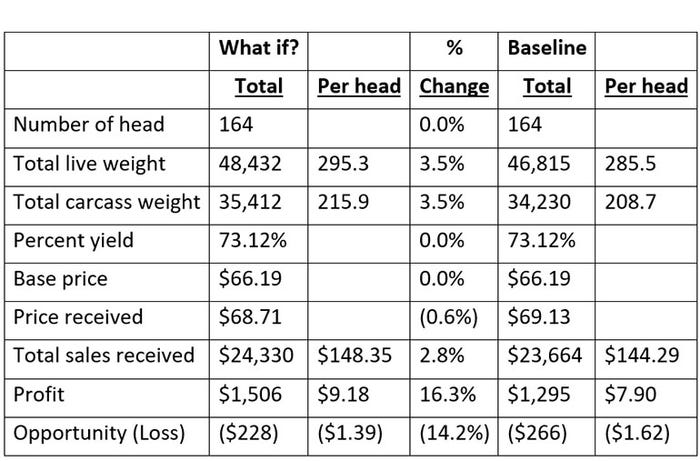Is your marketing team learning from every killsheet?
Part 2 on getting the most profit out of each load of market hogs.
May 28, 2020

Successful hog feeding operations collect data on everything, for example, protein levels of feed ingredients, pH of water, range of pig age/weight entering nursery and pounds of pork produced per pig space per year.
But do they know the profitability of the pigs being loaded on the truck by head, by load or by the whole pig group compared to the most profitable killsheet weight category?
Do they know:
The "most profitable" killsheet weight category?
The weight per head distributions around that "most profitable" weight for each load and the whole pig group?
Profit opportunity: Hundreds of dollars per load introduced readers to the RPOT Analysis, or Right Pig on the Truck.
Many hundreds of dollars per load and tens of thousands of dollars per pig group depend on the answers to these questions. These hundreds and thousands of dollars are the difference between "shipping a load of pigs" and "putting the Right Pig on the Truck." Yet these amounts of profit are "left on the table" while killsheets are collected and tucked away somewhere. A wealth of marketing data that should be transformed into actionable marketing information is largely ignored.
The RPOT Analysis and Report show the marketing team (the truck scheduler, the marker and the sorters) today, the results of the load that was shipped yesterday. The report shows the profit per head, the number of pigs in each killsheet weight category and the effects on load profitability due to "heavy" pigs, "light" pigs and those that fall in the "sweet range."
The report is like a speedometer, you glance at the speedometer and automatically make little adjustments. With this report, you glance at it and make those adjustments. Like the speedometer, it helps you minimize penalties. Think about it, the marketing team learning from every killsheet.
The RPOT Analysis is a combination tool designed for management and the marketing team. It extracts and organizes information from the data-rich killsheet.
Issues and questions addressed for management and load schedulers
Opportunity loss of putting light pigs and heavy pigs on the truck,
The extreme importance (value) of getting load scheduling right. When should the next load be marketed from this group?
What marketing target weight yields maximum profit?
The cost of the load missing the contractual weight window,
When to transition from selling lighter pigs to heavier pigs and vice versa as seasonal market prices change,
Would expanded finishing capacity payoff? Extra capacity might allow more pig groups time to maximize per group profit.
Should finishing capacity govern sale weight, or should profitability of sale weight govern finishing capacity?
Would scales pay off in your operation?
Does it pay to spend more time and effort marking if it might result in more of the largest pigs for market being loaded on every load?
Who should be marking pigs? Is someone in your operation a marking star?
Issues and questions addressed for load scheduler, marker and sorters
Opportunity loss of putting light pigs and heavy pigs on the truck,
Optimum (most profitable) weight per head,
Are you selling the load and the whole pig group too light or too heavy?
When not to be afraid of increasing or decreasing sale weight by 10, 15 or 20 pounds per head,
The weight per head and loss of profit per head of pigs in the "too light" and "too heavy" weight ranges,
Does it pay to mark twice?
Using the RPOT Analysis to address several of the items listed above is illustrated with the following "what-if" analysis.
"What if" Analysis: Can we profitably sell at a heavier weight?
A pig that is too light generates as much as $40 per head less profit than a pig at the optimal weight. The same holds true for a pig that is too heavy; as much as $40 per head less profit. So how does the marketing team responsibly load 165 head of pigs on a truck without knowing that optimal weight per head? The answer is obvious, they can't.
On top of that, the optimal weight range moves up and down as prices change. Not putting the right pig on the truck costs most producers $1-$7 per pig loaded on the truck. That averages $4 per head or $660 per load. You ship how many loads each year? Knowing the optimal market weight is easily as important as knowing what feed efficiency ratio to reach for.
Many operators consistently sell whole loads of pigs that are too heavy or too light. Selling pigs heavier is a tactic to maintain output when weaned pig supply slips and selling pigs too light is a common response to believing certain packers just don't like heavy hogs. Let's look at a "too light" example.
Table 1 (a modified killsheet), is an RPOT analysis/report taken from a typical killsheet and a pig group closeout report. The 221-228 pound carcass weight range is identified as the most profitable weight range. From Column 3 we can calculate that:
7.9% of the load fell in the "highest profit" weight range,
3.0% of the load weighed more than optimal weight, and
89.0% of the load weighed less than optimal weight.

While most of the load was sold in a tight weight distribution, a glance at Column 3 makes us suspect the load could have been sold more profitably at a heavier weight. The producer wanted to test that idea and asked what would have happened if every pig in that load had been sold one weight category heavier. The RPOT model easily addresses that question.
Table 1 is the initial analysis. In that table, note the opportunity loss per head is already at an unusually low level; nearly 90% of the pig weights falling in the sweet range. The pig weights make up a tight pattern, just a little low.
The "What If" table is the analysis of the same load, had each pig of that load weighed one weight category heavier. Note, the number of head does not change, but the total weight of the load comes in 3.5% heavier. That's 7.2 pounds per head, carcass weight, heavier. Note the weight categories of Column 1 average about 7.2 pounds in size.

Table 2 compares the two loads, the original load and the "what if" load with each pig of the original load weighing one weight category heavier. That is a 3.5% increase in weight. Base price did not change, but price received did change because of a changing weight schedule moving over a static price schedule. Total sales receipts increased 2.8% because of increased quantity sold and a slight decrease in price. Profit jumped 16.3% or $1.28 per head because sales receipts increased 2.8% and expense increased 2.0%. Yes, heavier pigs would have been more profitable.

The process of recognizing the whole load of pigs was sold too light and experimenting with a heavier weight, along with identifying the most profitable weight range and learning the opportunity loss of the "too light" and "too heavy" pigs is simply steps toward putting the right pig on the truck. The RPOT Analysis is the tool that equips the marketing team to learn from every killsheet.
For more information, contact Robert Aukes, 515-255-3404, or Mark Storlie, 515-708-7675.
Sources: Robert Aukes and Mark Storlie, who are solely responsible for the information provided, and wholly own the information. Informa Business Media and all its subsidiaries are not responsible for any of the content contained in this information asset. The opinions of these writers are not necessarily those of Farm Progress/Informa.
You May Also Like



